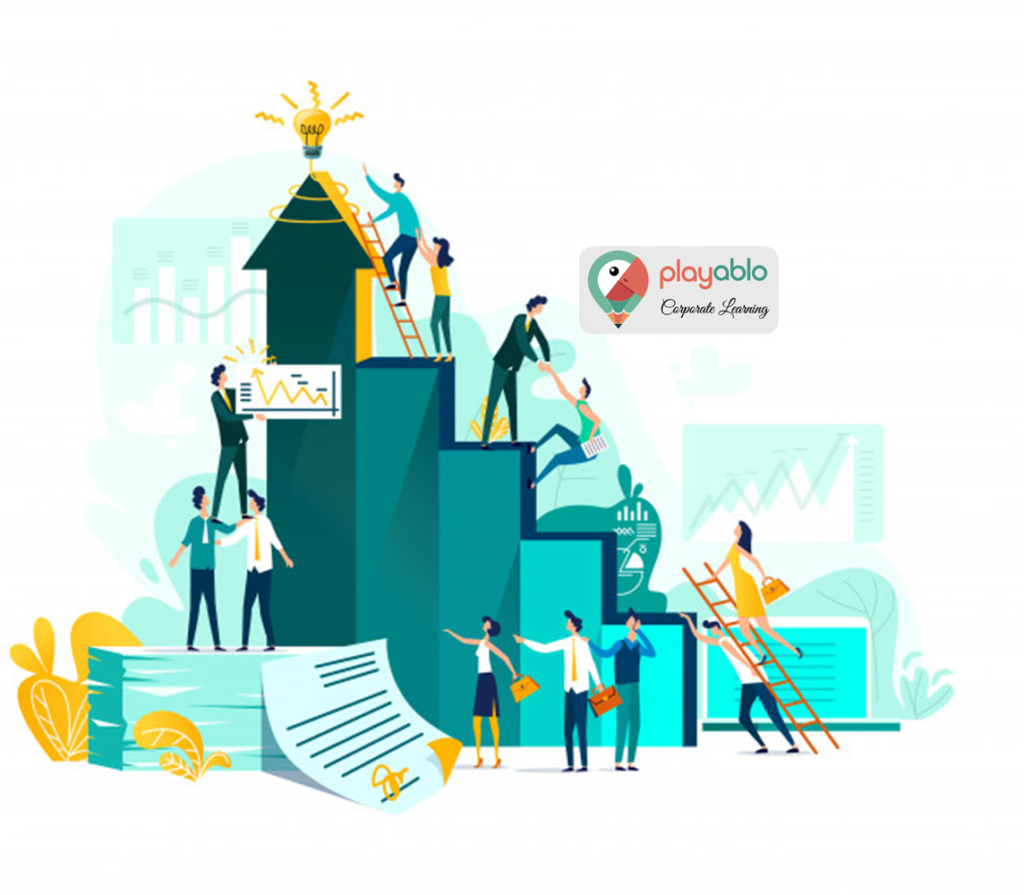Workforce re-skilling and upskilling have become hot subjects of discussion in both academia and business. The digitization of work and artificial intelligence, often known as the Fourth Industrial Revolution, is driving the focus on skills, which has escalated due to the COVID-19 pandemic. According to the World Economic Forum, one billion jobs, nearly one-third of all jobs today, will undergo transformation with 133 million new jobs created to match future demand. This transformation is impossible to achieve without the use of workforce re-skilling and upskilling tools.
While skilling is a hot topic, many human resource executives are unsure how to adopt and enforce a successful skilling strategy. According to PwC’s 2020 Annual Worldwide CEO Survey, only 17% of US CEOs and 30% of global CEOs thought their upskilling initiatives helped speed up digital transformation. Where do the chasms exist?
We’ve noticed that the world of adult learning is rapidly changing as organizations attempt to upskill and reskill their workforces. As a result, businesses may shape their reskilling and upskilling programs based on obsolete information and fallacies. Let’s debunk some of these myths for you.
Table of Contents
7 Myths About Workforce Re-skilling (and the Truths!)
Myth #1: Training programs are met with skepticism by employees

Employers are hesitant to implement workforce re-skilling programs because they believe it will not be worth the cost of employees unwilling to participate. This myth, however, is far from the truth. According to RiseSmart’s worldwide skilling survey, 55 percent of employees desire to learn new skills or refresh current ones. Around 94 percent of employees who participated in skilling projects in 2020 said they put their new or refreshed talents to use in a meaningful way, either fully or partially.
Employees are well aware that static abilities will not help them develop their careers in today’s fast-changing world of work. Being proactive about learning new skills might provide them with a competitive advantage. Employees frequently fail to see the link between their learning and their long-term job success. Employees are considerably more likely to be engaged and enthusiastic about the process if their organizations can make this aspect evident to them.
Myth #2: Employees will seek out new opportunities once they have learned new abilities
Companies do want to reskill their employees, but they’re worried that freshly upskilled employees would defect to a competitor and take their expertise with them. Employees value organizations that invest in their professional development. According to LinkedIn Learning research, 94% of employees would stay at a firm longer if their bosses invested in their professional development. 43 percent of employees say they wish to learn new skills to improve in their current function, and 30% say they learned new skills to advance within their company rather than looking for a new job. It’s apparent that workforce re-skilling isn’t just suitable for addressing business demands; it may also help with overall talent retention.

Furthermore, it is becoming increasingly crucial for businesses to guarantee that their workforce remains competent and employable, whether they stay with the company or not. Also, there is a tendency among employers to make voluntary commitments to ensure that individuals with current skills are not released into the labor market.
Myth #3: Skills development for team leaders, managers, and high-potential individuals should be a top priority for businesses
Most firms give skills training to team leads and supervisors, but reskilling isn’t uniformly dispersed. As a result, companies miss out on opportunities to identify and develop skills within their organization rather than relying on external recruitment. Organizations can better find fresh talents, hidden gems, and, potentially, future leaders if all employees at all levels have access to skill-building opportunities. It’s also less expensive to promote internal talent mobility through workforce re-skilling and upskilling opportunities than hiring and onboarding new employees.
Employers will profit from democratized skilling by establishing an inclusive and agile workforce with a growth mentality that is better prepared to respond to change and guaranteeing equal access to these resources.
Myth #4: For businesses, teaching technical skills should be a primary concern

Employers have focused on the fourth industrial revolution and the impact of automation, leading many to believe that talent will require specific IT, AI, and coding skills. While IT and software skills are crucial, HR leaders think employees should take courses to improve soft skills such as communication, cooperation, and leadership. Adaptability is an essential skill for the future, followed by communication and problem-solving. With this in mind, businesses quickly understand that soft skills will be crucial in the future workplace.
Myth 5: Effective learning can only take place in person
Some learning and development (L&D) leaders might snicker at this in a post-COVID world. Most people are aware that learning may be done effectively at a distance. Many L&D directors resisted this misconception internally until the global pandemic forced corporations to adapt to virtual learning when quarantines were implemented, arguing that their organizations preferred conventional in-person learning and that virtual learning participation was low. True, it’s easy for individuals to drift off during a Zoom or Webex learning webinar, but you may create engaging learning sessions without any effort.
Setting up a Zoom account and going about your business isn’t enough for online learning. Cognitive and socio-emotional learning are the two types of learning.
The first is mental. To fulfill our jobs, we absorb processes and make use of knowledge. We focus on information and abilities when we learn cognitively. That factual information could come from a class, an article we read, or a coworker showing us how to perform a new operation. We may convey it by meticulously developing and delivering a PowerPoint show. When people think about learning remotely, they frequently primarily consider how to make cognitive learning easier.
The socio-emotional method is the second way we learn. We learn how we – and others – feel and think about the new circumstance we’ve found ourselves in, as well as how to handle those feelings and thoughts. This form of learning demands us to pay attention to others and inquire about our own and others’ experiences.
When businesses are under duress, they frequently promote cognitive learning, even though socio-emotional learning is where we need to be focusing now as we adjust to drastically changed circumstances. Organizations can promote socio-emotional learning by having a call with a leader who shares their feelings and responding emotionally to new events, for example.
Using socio-emotional learning approaches, you may adapt your previous in-person content to an online distribution forum while maintaining your audience’s attention. Additionally, when you couple digital learning with tools such as PlayAblo‘s mobile-first, gamified micro-modules, you not only meet but also exceed the expectations of in-person training.
Myth 6: Formal education is the only way to learn

Several organizations in the present day encourage their employees to join dynamic teams or internal gigs, which are a popular form of on-the-job learning. We witnessed a jump in the utilization of active groups at the start of the COVID pandemic to handle new business models and quickly adapt to a fast-changing environment. Employees can get some of the best upskilling and workforce re-skilling learning by trying new things at work.
Stretch assignments allow us to learn, practice, and experiment during our career and leadership transitions. Increasing these stretch chances and connecting them to training experiences is a beautiful approach to improve your training results. Participants may put what they’ve learned into practice in a real-world setting while the business grows talent and fosters collaboration.
These types of learning are almost certainly already taking place in your company. Recognize this and encourage managers to lend their skills to other teams and empower employees to contribute outside their job areas. This informal interaction will not only assist you in resolving urgent issues but will also help to break down organizational silos, making future collaboration easier. Simultaneously, it will inspire people to take care of their development, learn how to link their interests with the organization’s goals, and create a growth attitude at the heart of agile enterprises.
Yes, traditional training has slowly replaced informal learning – which you may deliver via several channels – including digital platforms. Here, we discuss how you can sustain informal learning even when working remotely.
Myth 7: It’s a good idea to give staff a variety of choices
Of course, ensuring that an employee learning a new subject at an advanced level, for example, has access to more than simply starting courses is essential, but having too many options can paralyze a learner. Thousands of courses for upskilling and workforce re-skilling have been provided to most employees by their employers. It’s simple and inexpensive to accomplish now, thanks to the advent of massive open online courses (MOOCs) and online learning. Despite this, the majority of the businesses claim that their use of these technologies is appalling. Employees, on the other hand, continue to request greater training and skill development. What exactly is going on?
Employees can benefit from having a qualified advisor comb through the available courses and select those that fulfill their learning objectives and are most suited to their learning style and time.
Ad: PlayAblo’s Enterprise-Grade Micro-Learning platform is built for the corporate learner. Micro-Learning, along with assessments and gamification features, ensures learning outcome measurement along with sustained engagement.
Find out more and request a custom demo!
Conclusion
As we try to stabilize our economy, workforce re-skilling will be a top priority for firms, HR leaders, governments, and workers this year. This priority is why it’s critical to put myths aside today to ensure that your organization’s talent is up to speed on the skills required to remain nimble during this period of fast change.
Ad: PlayAblo’s Enterprise-Grade Micro-Learning platform is built for the corporate learner. Micro-Learning, along with assessments and gamification features, ensures learning outcome measurement along with sustained engagement.
Find out more and request a custom demo!







Comments are closed, but trackbacks and pingbacks are open.